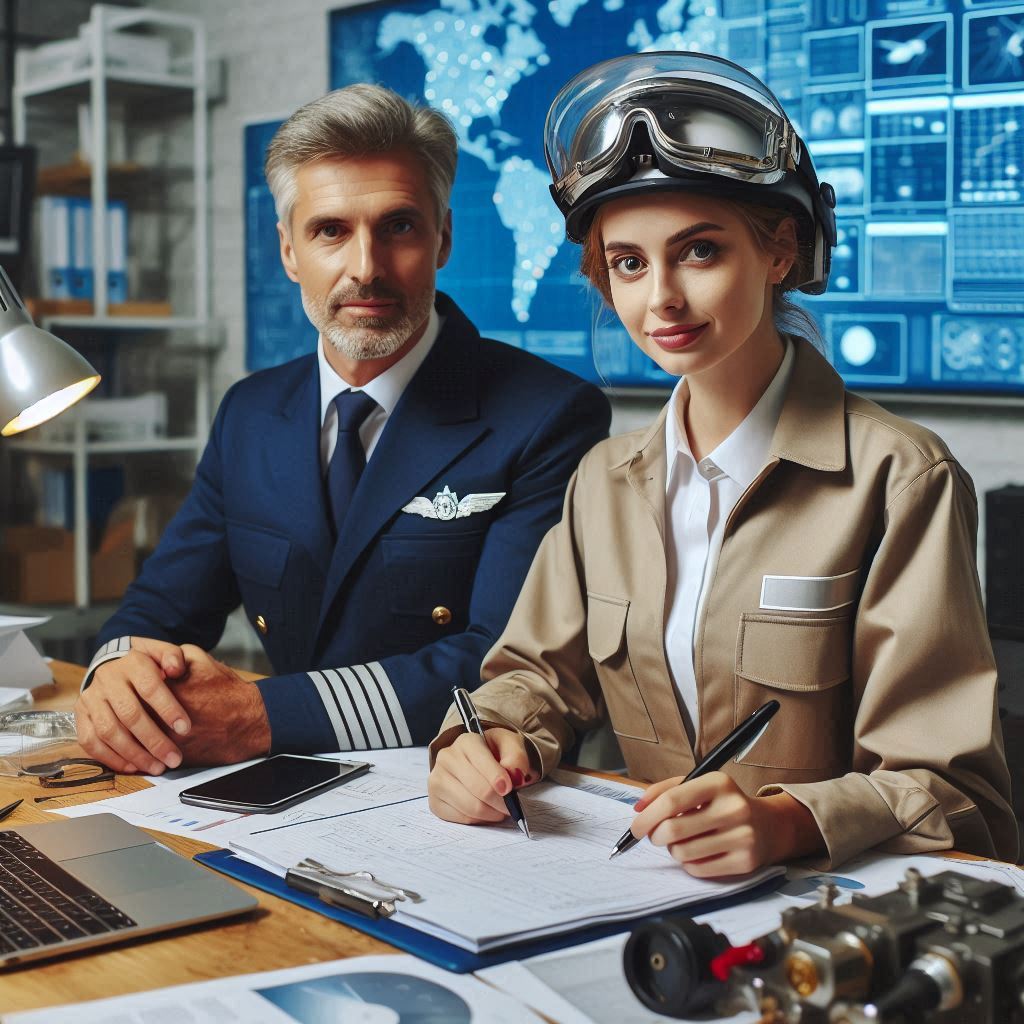Introduction
Brief Overview of the Aerospace Engineering Industry
The aerospace engineering industry is a dynamic and innovative sector that focuses on the design, development, testing, and production of aircraft, spacecraft, and related systems and equipment.
This industry encompasses a wide range of technologies and disciplines, including aerodynamics, materials science, avionics, propulsion, and structural analysis.
Importance of Staying Informed About Job Market Trends
In such a rapidly evolving industry, staying informed about job market trends is crucial for both current professionals and those aspiring to enter the field.
Awareness of industry trends helps individuals adapt to technological advancements, identify career opportunities, and enhance their employability.
Staying informed about industry conferences, seminars, and professional organizations also facilitates networking, which can lead to new job opportunities, collaborations, and career growth.
In closing, the aerospace engineering industry is a cornerstone of modern technology and innovation, and staying informed about job market trends within this sector is essential for career success and advancement.
Overview of Current Job Market Trends for Aerospace Engineers
In recent years, the job market for aerospace engineers has seen significant growth and changes.
This can be attributed to various factors such as advancements in technology, global events, and opportunities in different sectors.
Increased Demand Due to Advancements in Technology
Technological advancements are driving increased demand for aerospace engineers.
Innovations such as electric propulsion systems, autonomous and unmanned aerial vehicles (UAVs), and advancements in materials science are creating new opportunities.
Sustainable aviation technologies, including the development of alternative fuels and more efficient aircraft designs, are also areas where aerospace engineers are in high demand.
Additionally, the burgeoning space industry, with activities ranging from satellite deployment to space tourism, is generating significant employment opportunities.
Impact of Global Events on the Job Market
Global events, such as pandemics and geopolitical tensions, have a profound impact on the aerospace job market.
The COVID-19 pandemic, for example, led to a temporary decline in commercial aviation, affecting jobs related to passenger aircraft.
However, the pandemic also accelerated growth in sectors such as cargo aviation and UAVs for delivery and surveillance purposes.
Geopolitical tensions can influence defense spending, which in turn affects job opportunities in military and defense aerospace projects.
Understanding these fluctuations helps aerospace engineers anticipate and adapt to changing job market conditions.
Opportunities in Government, Commercial, and Private Sectors
Aerospace engineers have diverse opportunities across government, commercial, and private sectors.
In the government sector, agencies such as NASA, the European Space Agency (ESA), and the U.S
Department of Defense offer roles in research, development, and deployment of aerospace technologies.
These positions often focus on cutting-edge projects related to space exploration, defense systems, and advanced aviation technologies.
The commercial sector, dominated by major players like Boeing and Airbus, as well as numerous suppliers and service providers, offers a wide range of career paths.
These can include roles in aircraft design, manufacturing, systems integration, and maintenance.
The push towards more sustainable aviation practices is also creating new opportunities within the commercial aerospace industry.
In the private sector, the rise of space startups and companies like SpaceX, Blue Origin, and Virgin Galactic is opening new frontiers for aerospace engineers.
These companies are actively involved in developing commercial space travel, satellite deployment, and even ambitious projects like Mars colonization.
Engineers in this sector often work on innovative and groundbreaking technologies that push the boundaries of what is possible in aerospace.
In review, the job market for aerospace engineers is shaped by technological advancements, global events, and sector-specific opportunities.
Staying informed about these trends is crucial for career planning and growth in this exciting and ever-evolving field.
Skills and Qualifications Required for Aerospace Engineering Jobs
A successful career in aerospace engineering requires a combination of technical skills, continuous education, and relevant certifications. Here‘s an overview of the essential skills and qualifications needed to thrive in this field.
Technical Skills
Aerospace engineers must possess a strong foundation in several technical areas
- Aircraft Design: Proficiency in designing aircraft, including understanding aerodynamics, structural analysis, and materials science, is crucial. Engineers must be adept at using computer-aided design (CAD) software to create and test models.
- Propulsion Systems: Knowledge of propulsion systems, including jet engines, rockets, and emerging technologies like electric propulsion, is essential. This involves understanding thermodynamics, fluid mechanics, and combustion processes.
- Avionics: Avionics, the electronic systems used in aircraft, spacecraft, and satellites, is a critical area. This includes navigation, communication, and control systems. Engineers need to be familiar with software development, signal processing, and system integration.
- Materials Science: Understanding the properties and applications of materials, such as composites and alloys, used in aerospace structures is important for designing lightweight and durable components.
- Systems Engineering: Aerospace projects involve complex systems integration. Skills in systems engineering, including project management, quality assurance, and risk assessment, are valuable.
Importance of Continuing Education and Professional Development
The aerospace industry is continually evolving, driven by rapid technological advancements and changing regulatory landscapes.
As a result, continuing education and professional development are critical for staying current and competitive. Engineers should engage in lifelong learning through
- Advanced Degrees: Pursuing master‘s or doctoral degrees can provide deeper specialization and open up advanced career opportunities.
- Workshops and Seminars: Attending industry conferences, workshops, and seminars helps engineers stay updated on the latest trends and technologies.
- Online Courses and Certifications: Online platforms offer numerous courses on specialized topics, allowing engineers to gain new skills at their own pace.
Certifications and Licenses
Certain positions in aerospace engineering may require specific certifications and licenses to demonstrate expertise and compliance with industry standards
- Professional Engineer (PE) License: In the United States, obtaining a PE license can enhance an engineer‘s credentials, especially for roles involving public safety. This requires passing the Fundamentals of Engineering (FE) exam, gaining relevant work experience, and passing the PE exam.
- Project Management Professional (PMP) Certification: For engineers involved in project management, PMP certification can validate their skills in managing complex projects efficiently.
- Specialized Certifications: Various organizations offer certifications in specific areas of aerospace engineering. For example, the American Institute of Aeronautics and Astronautics (AIAA) offers certifications in aerodynamics, propulsion, and other disciplines.
- Federal Aviation Administration (FAA) Certifications: For roles related to aircraft maintenance, repair, and operations, FAA certifications such as the Airframe and Powerplant (A&P) license are required.
Essentially, a career in aerospace engineering demands a robust set of technical skills, a commitment to ongoing education and professional development, and, in some cases, specific certifications and licenses.
These qualifications ensure that engineers are well-equipped to tackle the challenges and innovations within the aerospace industry.
Read: Diversity in the US Architectural Scene: A Deep Dive
Impact of emerging technologies on the job market for aerospace engineers
Emerging technologies are significantly reshaping the aerospace engineering job market, creating new opportunities and requiring engineers to adapt and develop new skills.
Key areas where these technologies are making a substantial impact include the growth of the space industry, the development of electric and autonomous aircraft, and the influence of artificial intelligence (AI) and machine learning (ML).
Growth of the Space Industry and Opportunities in Space Exploration
The space industry is experiencing unprecedented growth, driven by increased investment from both government and private sectors.
This expansion is creating a wide range of opportunities for aerospace engineers.
Key areas of growth include
- Commercial Space Travel: Companies like SpaceX, Blue Origin, and Virgin Galactic are pioneering commercial space travel, making space tourism a burgeoning field. Aerospace engineers are needed to design, develop, and test spacecraft that can safely transport passengers to space.
- Satellite Deployment: The demand for satellite technology is rising, driven by needs for communication, Earth observation, and global navigation systems. Engineers are working on designing and launching new generations of small, efficient satellites.
- Deep Space Exploration: Missions to Mars, lunar bases, and asteroid mining are becoming more feasible. Engineers are required to develop the technologies necessary for long-duration space travel, habitat construction, and resource extraction.
Development of Electric and Autonomous Aircraft
The development of electric and autonomous aircraft is revolutionizing the aviation industry, creating new job roles and opportunities for aerospace engineers.
Key developments include
- Electric Propulsion Systems: The push towards sustainable aviation is leading to the development of electric aircraft. Engineers are working on electric propulsion systems, battery technologies, and energy management systems to create more environmentally friendly aircraft.
- Urban Air Mobility (UAM): Autonomous aerial vehicles, including air taxis and delivery drones, are poised to transform urban transportation. Engineers specializing in autonomous systems, navigation, and collision avoidance are in high demand to develop these technologies.
- Hybrid-Electric Aircraft: This technology aims to reduce fuel consumption and emissions, and engineers with expertise in both conventional and electric propulsion systems are needed.
Influence of Artificial Intelligence and Machine Learning on Aerospace Engineering
AI and ML are increasingly being integrated into aerospace engineering, impacting various aspects of design, manufacturing, and operations.
Key areas of influence include
- Predictive Maintenance: AI and ML are used to analyze data from aircraft systems to predict maintenance needs, reducing downtime and improving safety. Engineers with skills in data analysis and machine learning algorithms are essential for developing these systems.
- Design Optimization: AI and ML algorithms are used to optimize aircraft and spacecraft designs, improving performance and efficiency. Engineers are using these technologies to perform complex simulations and analyses that were previously not possible.
- Autonomous Systems: AI is critical for developing autonomous navigation and control systems for both aircraft and spacecraft. Engineers specializing in AI and robotics are working on creating systems that can operate independently, making air travel and space exploration safer and more efficient.
- Manufacturing and Quality Control: AI-driven automation and quality control systems are enhancing manufacturing processes. Engineers are needed to design and implement AI systems that can monitor and improve production lines, ensuring high-quality aerospace components.
Therefore, emerging technologies are transforming the aerospace engineering job market, offering exciting new opportunities while also requiring engineers to continually update their skills.
The growth of the space industry, the development of electric and autonomous aircraft, and the integration of AI and ML are key drivers of change, shaping the future of aerospace engineering.
Read: Freelance vs. Firm: Career Paths for US Architects
Diversity and Inclusion Initiatives in the Aerospace Engineering Field
Diversity and inclusion (D&I) initiatives are becoming increasingly important in the aerospace engineering field.
These initiatives aim to increase the representation of women and minorities, create a more inclusive workplace culture, and leverage the benefits of diverse teams for innovation and problem-solving.
Transform Your Career Today
Unlock a personalized career strategy that drives real results. Get tailored advice and a roadmap designed just for you.
Start NowEfforts to Increase Representation of Women and Minorities
The aerospace industry has traditionally been male-dominated, but there are ongoing efforts to increase the representation of women and minorities. These efforts include:
- Educational Outreach: Programs aimed at inspiring young women and minority students to pursue careers in STEM (Science, Technology, Engineering, and Mathematics) are critical.
- Recruitment Initiatives: This includes partnering with historically black colleges and universities (HBCUs) and other minority-serving institutions to create pipelines for students into the aerospace industry.
- Professional Development Programs: Providing career development opportunities for women and minorities within the industry helps to retain and advance diverse talent. Programs that offer leadership training, mentorship, and sponsorship are essential for career growth.
- Policy Changes: Companies are adopting policies that promote diversity and inclusion, such as bias training, equitable hiring practices, and the establishment of diversity councils to oversee and drive D&I efforts.
Importance of Creating a More Inclusive Workplace Culture
Creating an inclusive workplace culture is vital for the success of diversity initiatives.
An inclusive culture ensures that all employees feel valued, respected, and supported.
Key aspects of fostering such a culture include
- Inclusive Leadership: Leaders play a crucial role in setting the tone for an inclusive environment. Inclusive leadership involves actively listening to diverse perspectives, promoting equity, and demonstrating commitment to D&I values.
- Employee Resource Groups (ERGs): ERGs provide a platform for employees to connect, share experiences, and support each other. These groups can also offer valuable insights to the organization on how to improve inclusivity.
- Work-Life Balance: Policies that support work-life balance, such as flexible working hours, parental leave, and remote work options, can make the workplace more accommodating for everyone, particularly for women and minorities.
- Training and Awareness: Regular training on diversity, equity, and inclusion topics helps to raise awareness and reduce unconscious bias. Creating a culture of continuous learning and improvement is essential.
Benefits of Diverse Teams in Driving Innovation and Problem-Solving
Diverse teams bring a range of perspectives, experiences, and ideas, which can significantly enhance innovation and problem-solving.
The benefits of diversity in teams include
- Enhanced Creativity: Diverse teams are more likely to generate innovative solutions because they draw on a broader range of experiences and viewpoints. This creativity is essential in the aerospace industry, where complex problems often require out-of-the-box thinking.
- Better Decision-Making: Research shows that diverse teams make better decisions because they consider a wider array of factors and alternatives. This leads to more robust and effective solutions.
- Improved Performance: Companies with diverse workforces often perform better financially and operationally. Diversity can lead to higher employee engagement and satisfaction, which in turn drives productivity and success.
- Broader Market Reach: A diverse team can better understand and serve a global customer base. In the aerospace industry, where clients and partners are located worldwide, this is a significant advantage.
Generally, diversity and inclusion initiatives are essential for the aerospace engineering field.
Increasing representation of women and minorities, fostering an inclusive workplace culture, and leveraging the benefits of diverse teams are critical for driving innovation, improving problem-solving, and ensuring the industry’s long-term success and sustainability.
Read: Post-Pandemic Design Trends: US Architects Adapt

Delve into the Subject: Understanding Petroleum Reservoir Engineering
Salary and job outlook for aerospace engineers
Understanding the salary and job outlook for aerospace engineers is essential for both current professionals and those aspiring to enter the field.
This includes knowledge of average salary ranges across different sectors, the projected growth rate for jobs, and factors that influence salary trends.
Average Salary Range for Aerospace Engineers in Different Sectors
Aerospace engineers can work in various sectors, each offering different salary ranges. Here are some average salary figures based on sector:
- Commercial Aviation: Engineers in commercial aviation typically work for major aircraft manufacturers like Boeing and Airbus. The average salary in this sector ranges from $80,000 to $120,000 per year, depending on experience and role.
- Defense and Military: Aerospace engineers in the defense sector, working for companies like Lockheed Martin, Northrop Grumman, and Raytheon, can expect higher average salaries due to the complexity and critical nature of their work.
- Space Industry: Engineers working for space exploration companies such as SpaceX, Blue Origin, and NASA typically earn between $85,000 and $125,000 annually. Specialized roles in space exploration, particularly those involving advanced research and development, may command higher salaries.
- Research and Development: Aerospace engineers involved in R&D, whether in academia, government agencies, or private research firms, generally earn between $75,000 and $110,000 per year. Salaries can vary widely based on the level of expertise and the specific research focus.
Projected Growth Rate for Aerospace Engineering Jobs
The job outlook for aerospace engineers is influenced by ongoing technological advancements and increasing investment in both aviation and space exploration.
According to the U.S
Bureau of Labor Statistics (BLS), employment of aerospace engineers is projected to grow by about 6% from 2022 to 2032, which is about as fast as the average for all occupations.
This growth is driven by several factors:
- Commercial Aviation: Continued demand for more fuel-efficient and environmentally friendly aircraft is spurring innovation and job creation.
- Space Exploration: Increased private and government investment in space missions, satellite deployment, and space tourism is expanding opportunities.
- Defense Spending: Ongoing investment in defense technologies, including unmanned systems and advanced aircraft, supports job growth in the military sector.
Factors Affecting Salary Trends
Several factors influence salary trends for aerospace engineers, including location, experience, education, and industry demand:
- Location: Geographic location plays a significant role in salary levels. Engineers working in regions with a high concentration of aerospace companies, such as California, Texas, and Washington, tend to earn higher salaries.
- Experience: Entry-level aerospace engineers may start with salaries around $70,000 to $85,000 per year, while mid-career professionals with 5-10 years of experience can earn between $90,000 and $120,000.
- Education and Specialization: Advanced degrees and specialized skills can significantly enhance earning potential. Aerospace engineers with a master‘s degree or PhD, particularly in high-demand areas like propulsion, avionics, or systems engineering, often earn higher salaries.
- Industry Demand: Fluctuations in industry demand, driven by economic conditions, technological advancements, and government policies, can impact salary trends. For instance, a surge in demand for electric and autonomous aircraft can lead to higher salaries for engineers with expertise in those areas.
In general, aerospace engineering offers a promising career path with competitive salaries and a positive job outlook.
Salaries vary by sector, location, experience, and specialization, and the field is expected to grow steadily, driven by advancements in technology and increasing investment in aviation and space exploration.
Read: The Intersection: Architecture & Tech in Modern USA.
Strategies for Staying Competitive in the Job Market
To remain competitive in the aerospace engineering job market, it’s important to adopt proactive strategies that enhance your skills, expand your network, and stay informed about industry developments.
Here are some effective approaches
Networking with Industry Professionals and Attending Conferences or Events
Building and maintaining a strong professional network is crucial for career advancement in aerospace engineering. Here‘s how you can leverage networking and industry events:
- Attend Industry Conferences: Participate in conferences such as the International Astronautical Congress (IAC), the Aerospace Industries Association (AIA) events, and others relevant to aerospace engineering.
- Join Professional Organizations: Becoming a member of professional organizations like the American Institute of Aeronautics and Astronautics (AIAA), the Society of Aerospace Engineers, or similar groups can help you connect with peers and experts in the field.
- Engage in Online Forums and Social Media: Platforms like LinkedIn, industry-specific forums, and social media groups are valuable for connecting with professionals and staying up-to-date on industry news.
Updating Skills and Knowledge with Online Courses or Workshops
Continuing education is key to staying relevant and competitive.
Consider these strategies to keep your skills and knowledge current
- Online Courses and Certifications: Platforms like Coursera, edX, and Udacity offer courses and certifications in aerospace engineering topics such as advanced propulsion systems, materials science, and data analysis.
- Workshops and Training Programs: Look for workshops and training programs offered by industry organizations, educational institutions, or technology providers. These programs often focus on specific skills or technologies that are currently in demand.
- Advanced Degrees: Pursuing a master‘s or doctoral degree in aerospace engineering or related fields can provide deeper specialization and open up advanced career opportunities. Many universities offer part-time or online options to accommodate working professionals.
Seeking Mentorship Opportunities and Staying Informed About Industry Trends
Mentorship and staying informed are vital for career growth and adaptation to industry changes
- Find a Mentor: Seek out experienced professionals who can provide guidance, advice, and feedback. A mentor can help you navigate your career path, offer insights into industry trends, and assist with professional development.
- Stay Informed About Industry Trends: Regularly read industry publications, research papers, and news articles to stay up-to-date on the latest developments in aerospace engineering.
- Participate in Professional Development Programs: Engage in programs that focus on leadership skills, project management, and other areas that can enhance your career prospects. Many organizations and institutions offer specialized training that can help you advance to higher-level positions.
In essence, staying competitive in the aerospace engineering job market involves actively networking with industry professionals, continuously updating your skills and knowledge, seeking mentorship, and staying informed about industry trends.
By adopting these strategies, you can enhance your career prospects, adapt to changes in the field, and position yourself for success in this dynamic and evolving industry.
Find Out More: The Role of GIS in Transportation Engineering
Conclusion
Emerging technologies are reshaping the aerospace landscape, with innovations in space travel, electric and autonomous aircraft, and artificial intelligence creating new opportunities and demands.
Engineers must adapt to these changes by acquiring new skills and staying informed about technological advancements.
Diversity and inclusion efforts are crucial for fostering innovation and improving problem-solving within the industry.
By increasing representation and creating inclusive workplace cultures, the aerospace field benefits from a wider range of perspectives and ideas.
The salary and job outlook for aerospace engineers remain promising, with competitive salaries across various sectors and steady job growth projected.
Factors such as location, experience, and education play significant roles in influencing salary trends and career opportunities.
To stay competitive in this dynamic field, it‘s vital for aerospace engineers to engage in proactive strategies.
Networking with industry professionals, attending relevant conferences, and updating skills through courses and workshops are essential.
Seeking mentorship and staying informed about industry trends will also support long-term career success.
Showcase Your Business Today
Reach thousands of readers actively exploring professional services. Publish your business profile and grow your audience now.
Publish Now[E-Books for Sale]
The Big Book of 500 High-Paying Jobs in America: Unlock Your Earning Potential
$19.99 • 500 High-Paying Jobs • 330 pages
Explore 500 high-paying jobs in America and learn how to boost your career, earn more, and achieve success!
See All 500 High-Paying Jobs of this E-Book
1001 Professions Without a Degree: High-Paying American Jobs You Can Start Now
$19.99 • 1001 Professions Without a Degree • 174 pages
Discover 1001 high-paying jobs without a degree! Unlock career tips, skills, and success strategies for just $19.99!




